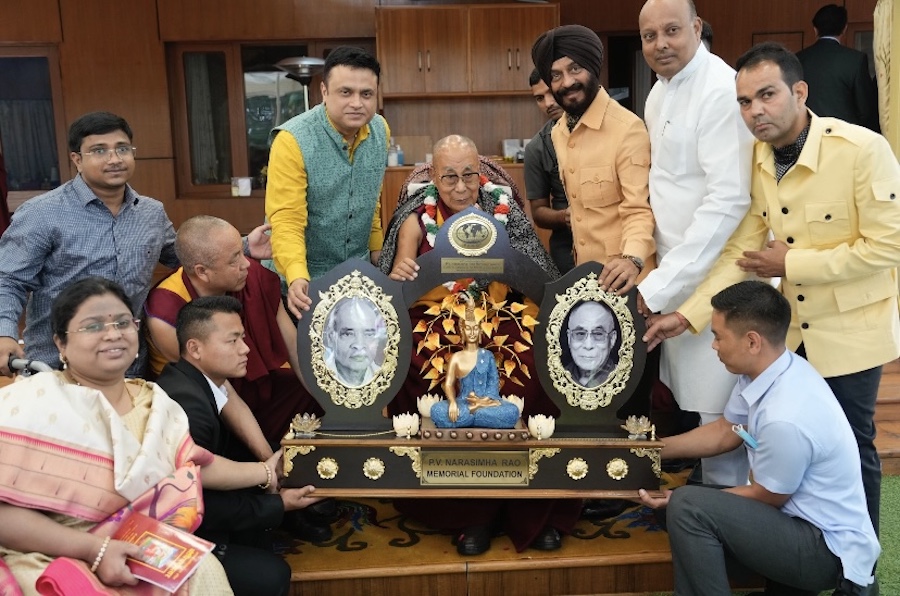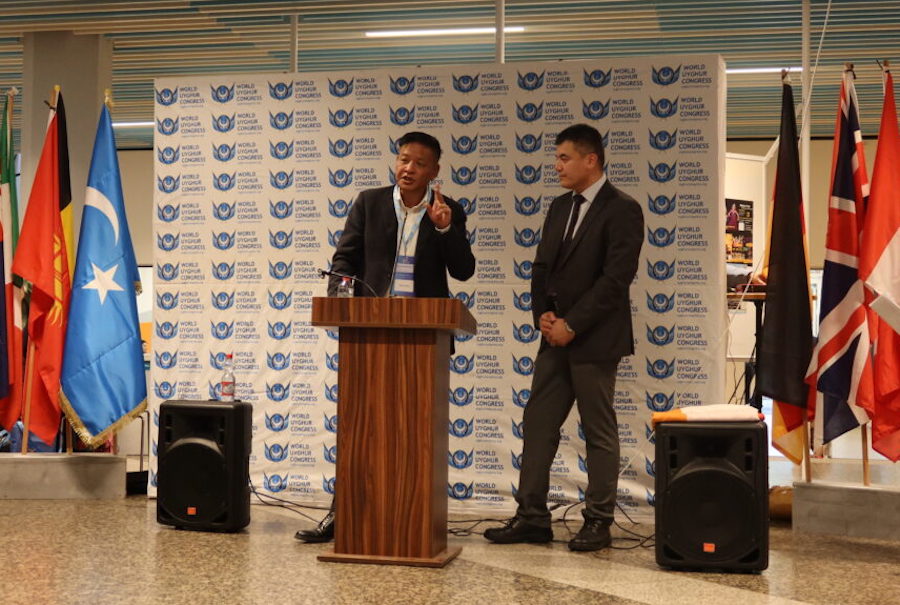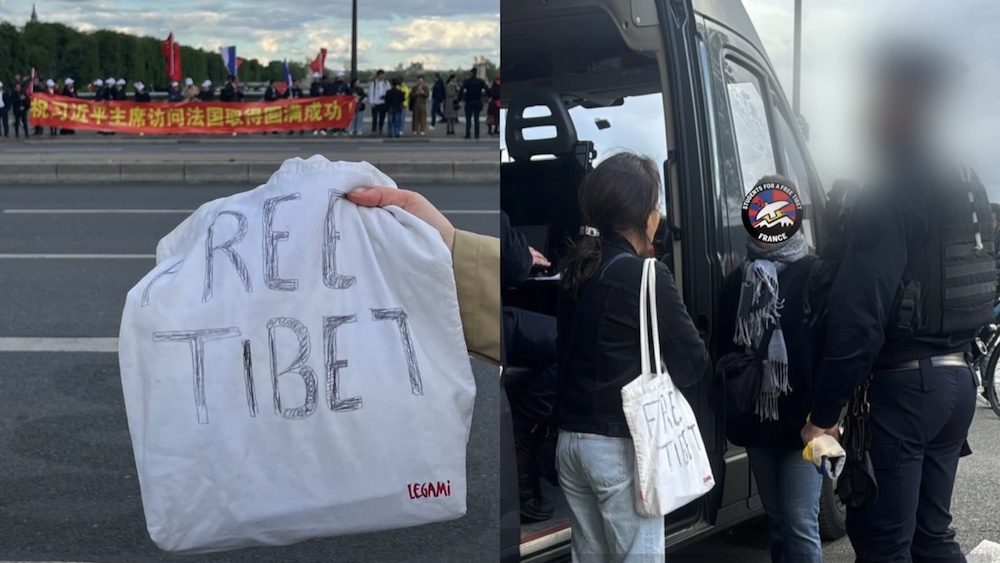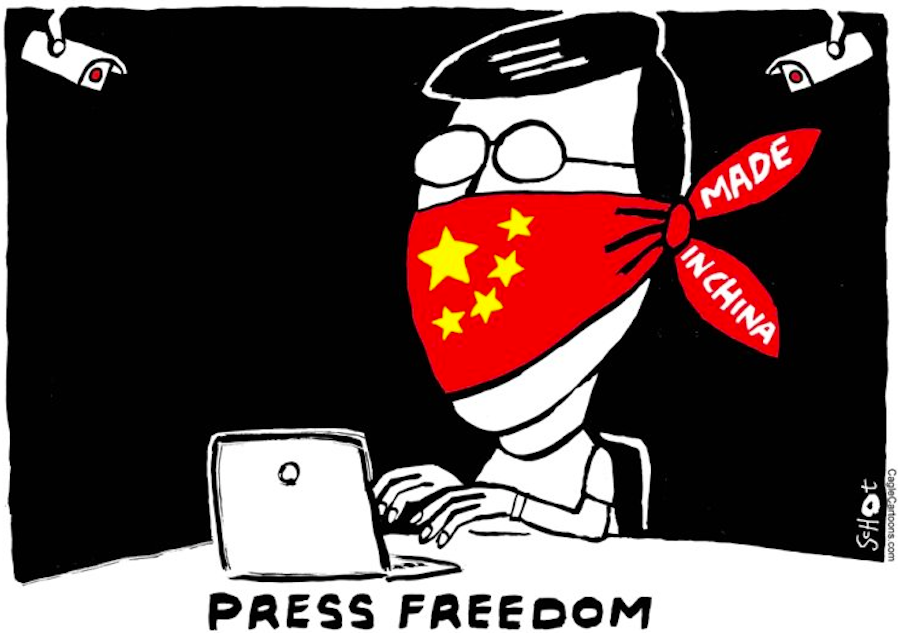PART III
By Julian Gearing
KATHMANDU – If you are a Buddhist you may want to try this, but you would be wise to exercise a degree of caution. Jump from an aircraft at 12,000 feet and adopt the Lotus position. Make sure you have a parachute on. Be aware, though, that when you sit in this meditation pose, you fall much faster than normal spread-eagled skydivers.
Lama Ole Nydahl had a parachute on when he decided to jump and “sit” – a position suggested to him by his parachuting instructor. The Danish Buddhist guru is no stranger to dropping from the sky. This was his 88th jump. But caught up in the “wonderful experience”, he failed to take full account of the increased velocity of plummeting to Earth “Buddha-like”.
Lama Ole, as he is known, teaches his students of Diamond Way Buddhism how to prepare for death. On this sunny day in July in Germany he narrowly avoided having to put his teachings of “conscious dying” into practice. Realizing that he was about to hit the ground, he pulled his emergency ripcord. His ‘chute partially slowed his descent as his body smashed on to a concrete landing site.
 From his hospital bed, the broken and bruised 63-year-old Buddhism teacher explained that people could obviously imagine how attractive the idea of sitting during free-fall parachuting sounds to a Buddhist lama. But he admitted the accident was his own fault. He was “due for some essential teachings on sickness and pain”, he said, and that he hoped this would increase his “maturity as a teacher”. Now he is up walking and teaching again.
From his hospital bed, the broken and bruised 63-year-old Buddhism teacher explained that people could obviously imagine how attractive the idea of sitting during free-fall parachuting sounds to a Buddhist lama. But he admitted the accident was his own fault. He was “due for some essential teachings on sickness and pain”, he said, and that he hoped this would increase his “maturity as a teacher”. Now he is up walking and teaching again.
If you mention the name Lama Ole to a follower of the Tibetan Karma Kagyu Buddhist school, chances are you will get either of two responses – a smile or a grimace. The response depends on whose “side” the follower is on. A major split has developed in this school, one of the four main schools of Tibetan Buddhism, possibly the most popular and accessible school in the West. Crucial to the school is the lineage holder, the high master. Tibetans believe in reincarnation and that high lamas on the brink of enlightenment reincarnate, coming back again and again to help others on the path to nirvana. Just like the Dalai Lama, who is said to have come back again and again, so with the head of the Karma Kagyu school, the Karmapa.
There was only one 16th Karmapa, who died in 1981. Now the problem is that there are two 17th Karmapas. Lama Ole supports Karmapa Thaye Dorje, recognized by Shamar Rinpoche, a high lama in the Karma Kagyu school. Thaye Dorje is not the lama who made the headlines in January 2000 with his dramatic escape from Tibet and his arrival on the Dalai Lama’s doorstep in Dharamsala in India. That’s Karmapa Urgyen Trinley, who was recognized by Tai Situ Rinpoche, another high lama. The Dalai Lama endorsed Karmapa Urgyen Trinley’s recognition.
If you are confused, it’s understandable. The fact that there are two separate groups of Tibetan lamas who have recognized and support two separate Karmapas has resulted in violent clashes, court cases and distinctly un-Buddhist behavior.
But if the Tibetans are split, so are the school’s Western followers. Each side bad-mouths the other. Critics say Karmapa Urgyen Trinley was fraudulently recognized, claiming a letter said to have been written by the 16th Karmapa pointing to where he would be reborn was a fake. They claim the lama is not the “real” Karmapa. And they are angry with the Dalai Lama, who belongs to the Gelukpa school, interfering by publicly stating his acceptance of the boy. Critics on the other side dispute the recognition of Karmapa Thaye Dorje and question why Shamar, who recognized him, challenged his competitors, then backed down, then appeared to have changed his mind and challenged again.
It is virtually impossible as a follower of the Karma Kagyu school to tiptoe along the knife-edge that divides followers of the two Karmapas. You either believe in one or you believe in the other. Period. Buddhist centers have split or joined one side or the other. In the West, the split has not happened without heartache.
Before one understands how traumatic this competition for the Karmapa throne has become for Western followers, the controversy has to be understood against the backdrop of struggle and transition suffered by the Tibetans. After the Dalai Lama and more than 100,000 Tibetans fled Chinese oppression in their homeland in 1959, they tried to pick up their lives in exile, with their headquarters now in Dharamsala. This has proved to be largely a success story, in terms of civil administration, public profile and preservation of their culture and religion.
Buddhism forms the core of Tibetan society and the main Buddhist schools of Gelukpa, Karma Kagyu, Nyingma and Sakya have done well in re-establishing themselves in the Indian subcontinent and in centers around the world. While the record of the high lamas who run these schools has not been without blemish – a few sex and drug scandals blotting their image – the transition from the largely feudal confines of old Tibet to an acceptance by the wider world is ongoing and bearing fruit.
Tibetan Buddhism’s growing “popularity” in the West has a lot to do with the 1989 Nobel Peace Prize winner, the Dalai Lama, and everybody from Hollywood actor Richard Gere to the Beastie Boys pop group jumping on the bandwagon. The “Tibet cause” is “in” and everything from prayer wheels to stupas is “cool”.
But when the Tibetan lamas were thrown into exile they brought with them not only their tried and tested tools to pursue enlightenment, they also brought monastic politics, cultural practices and struggles for power that do not always translate well under the scrutiny of the modern world.
Buddhist monasteries were set up by the exiled lamas to replicate old Tibet. In this they have been largely successful. Monasteries for Tibetan monks have done well. But their track record of interfacing with the outside world has been mixed. Call it a work in progress. While many of the top lamas have worked hard to maintain their lineage, their teachings and tried to help foreigners interested in Buddhism, not everything has worked well in translation.
What has helped is the work of a few dedicated Westerners. American Robert Thurman, now recognized as one of the world’s leading Buddhist scholars and a champion of the Dalai Lama, spent years in monastic isolation to come out and bring the wisdom to the West. Tenzin Palmo, aka Diane Perry, swapped proposals of marriage in the East End of London for 12 years meditating in caves in the Himalayas, and is now bringing women’s liberation to cloistered nuns. Lama Ole and his wife Hannah swapped drugs on the hippie trail to Kathmandu for a nomadic life of Buddhist teaching to tens of thousands of people around the world.
The help of these Westerners is needed, largely because of the linguistic and cultural barriers. For typical unenlightened Westerners coming to Tibetan Buddhism for the first time, they are faced with a pantheon of fearsome Buddhist deities, archaic mantras, and a choice of different paths and schools. Then there is the language problem. Much of the beauty of Tibetan Buddhism, say those in the know, can only be found through a thorough grasp of the Tibetan language. For some, finding their way at first is nothing short of a nightmare.
What path to take? Monastic or lay? Which school to choose? Should the teacher be a Tibetan? Or a Westerner? How do you choose?
There are no standard answers. From conversations with high lamas, monks and Western followers, the choice depends on a number of factors, but largely boils down to the seeker’s needs. Tenzin Palmo says you don’t have to rush off to live in a cave to begin on the path to enlightenment. Speaking at her nunnery at Tashi Jong monastery not far from Dharamsala, she says there are many paths on offer and many methods. The choice of teacher is vitally important. “Shop around and don’t be in a hurry,” she says.
Yet when do starry-eyed Westerners make a careful choice? Choosing a job, choosing a school, this takes careful analysis. But spiritual choice often seems to come down to a whim or gut reaction. Western values of balance and objectivity don’t really come into play. Take the case of one British woman who dropped a well-paid career at the sight of a postcard of the young Karmapa Urgyen Trinley when she was on vacation in Nepal about decade ago. “It was his eyes,” she says, referring to the young lama’s penetrating gaze. A decade later she is still wearing her red robes.
“His eyes” – you hear it a lot. People are drawn to Urgyen Trinley’s penetrating eyes. But it goes to show that the teacher, or in this case the head of the Buddhist lineage, matters. He is the person through whom the teachings are passed on. He is the focus of adoration. Hence the care needed in the search for a reborn lama.
If you are a Buddhist and believe in reincarnation, how do you “know” whether Urgyen Trinley or Thaye Dorje is the “real” Karmapa? Of course there is no easy answer. Some say the real Karmapa will prove himself in time. Lama Phuntsok, an aide to Urgyen Trinley, has a more practical approach. “People should try to meet both Karmapas, then decide,” he says. Few, if any, have taken this logical path. But even then, you cannot sit on the fence, saying both Karmapas are great. You have to choose – hence the great divide.
So how is this competition measuring up? And what effect is it having on Western followers? Trying to estimate the level of support for either side is not easy. Followers are said to number in hundreds of thousands and official centers number over 1,000. It is both a numbers game and also a question of which high lamas back which side.
Set in the forested hills of Scotland, Karma Samye Ling monastery is a bastion of support for Urgyen Trinley. This is the base of Akong Rinpoche, who was the man who sought and found in Tibet the young nomad boy destined for the Karmapa throne. According to Kenneth Holmes, a Buddhist author and teacher resident at the monastery, the first five years of the contest, after Urgyen Trinley was proclaimed the Karmapa, were “traumatic and confusing” for Westerners. “Things have settled now and most Kagyu centers and their followers in the West have realized that Urgyen Trinley is supported by the vast majority of important Kagyu lamas. The main exception concerns the numerous small Dharma groups worldwide following the controversial Danish Buddhist teacher Ole Nydahl.”
Holmes, who has written a book Karmapa, makes a point of trying to distinguish between numbers and names. He says that when people hear of a split, they tend to think of a 50-50 split, but, in the Karmapa issue, “those following Thaye Dorje are a small minority”, he claims, and “nearly all the great lamas of the Karma Kagyu tradition support Urgyen Trinley”.
Is it acceptable to have two Karmapas? Holmes says there is often, both in the press and the public, a desire for fairness and objectivity that, as soon as it hears there are two contenders in a domain about which it knows little, wants to give each the same status. “But imagine that someone suddenly appears and proclaims himself king of England or the true pope! One cannot give such a person equal credence and one wonders immediately what is the agenda behind their claim,” he says. Clearly two Karmapas cannot sit on the same throne.
One follower of the Karma Kagyu school who has witnessed the split first-hand is Tomek Lehnert, who stands on the other side of the divide. His book Rogues in Robes provides an account of the “Karmapa controversy” as told from the position of a close aide to Lama Ole. Lehnert, a Pole, is Lama Ole’s “action man”, constantly on the road with the Danish teacher as he travels around the world giving Buddhist teachings and empowerments.
Lehnert provides a chart that shows a rundown of Buddhist centers around the world that support either Karmapa candidate. By his reckoning, 612 centers support their Karmapa Thaye Dorje, and 425 that support Karmapa Urgyen Trinley.
“As a result of the bitter fighting between high lamas, some practitioners lost confidence in Buddhism in general,” he says. “Some Westerners felt let down or even betrayed by the Tibetan teachers. This may have brought about crises in values in people’s lives.” Some became cynical about Buddhism, he says, and “threw the baby out with the bath water”.
He claims that some Western and Eastern followers became deaf to reason, logic or common sense when defending their choice of Karmapa and fanatical behavior became prevalent. For some, the conflict has placed Tibetan Buddhism on a par with other scandal-ridden groups and sects, he says. The conflict enforces the prevailing view that when it comes to spirituality – especially of the Eastern kind – what matters most is money, power and control of the followers.
The struggle for the throne has damaged the institution of the Karmapa. But it is not all bad. Lehnert and some other followers of the Karma Kagyu school say the Karmapa controversy has encouraged Western followers to become independent, examining their teachers and becoming more critical of spirituality in general. Common sense, logic and reason now matter. And the teacher must be proved on his or her merit, not merely on the basis of historical title or spiritual recognition.
“People have learned to discriminate,” says Lehnert. “People have become more aware of what kind of Buddhist methods are useful in the West. Western practitioners have had to find their own strength. The childlike dependency on a lama or teacher has no place anymore.”
Maybe so, but you tell that to the Western followers who sit swooning at a lama’s feet. The Lord Buddha is supposed to have taught that it is good to ask questions and have an open mind. Because of the Karmapa controversy, questions will be asked more. While there will obviously be those who find it difficult to have an open mind, the debate may help to open up the religion. It may at times prove bitter, but the search for the truth is essential.
Some Buddhist teachers say Western approaches to teaching and examining Tibetan Buddhism will increasingly play more of a part in how the religion is accepted in the West. As more and more qualified Western teachers come forward, the “cultural” side of Tibetan Buddhism will diminish. That means fewer Westerners going around and around in circles spinning prayer wheels and more focus on the truth. As time goes on, Tibetan Buddhist “politics” will diminish as the negative practices of old Tibet are exposed. The importance of the Tibetan master will slowly diminish, while the importance of the Western master will slowly rise.
All this has to happen if Tibetan Buddhism is to survive as a viable, dynamic and attractive religion in the West. The Western path to enlightenment is beginning to be trod. Some new methods may prove useful. Some may be dumped in the rubbish bin.
Whether or not parachuting becomes part of a “fast course” to enlightenment remains to be seen. Lama Ole is not saying it is “a must”. Just that it is useful for examining the mind. He encourages his followers to jump. About 1,000 have jumped so far. He says he has even asked Karmapa Thaye Dorje to jump.
So will he jump? Sitting in his house in Kalimpong in India, Thaye Dorje smiles at the thought of jumping out of an aircraft. “I am having second thoughts about parachuting after Lama Ole’s accident,” he says with a grin.
Tibetan lamas don’t fall from the sky. It’s not the Tibetan way. Like his “competitor” Urgyen Trinley, Thaye Dorje says he prefers not to be drawn into the rights and wrongs of how each boy was recognized. So what is his message for Westerners perplexed by the controversy? “Focus on the Buddhist Dharma, the teachings,” he says. “Ignore the politics.”
This is the concluding article of this series.









